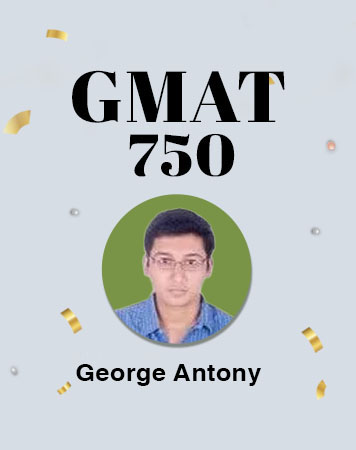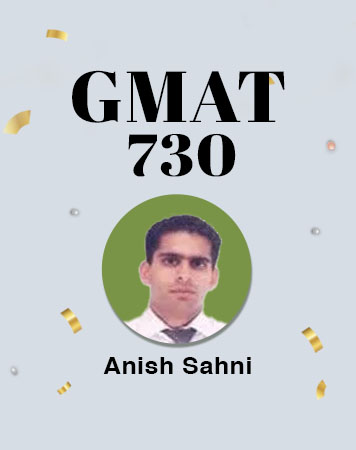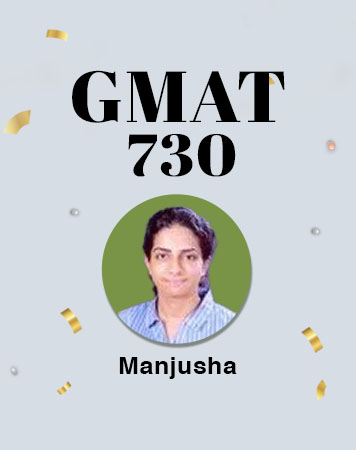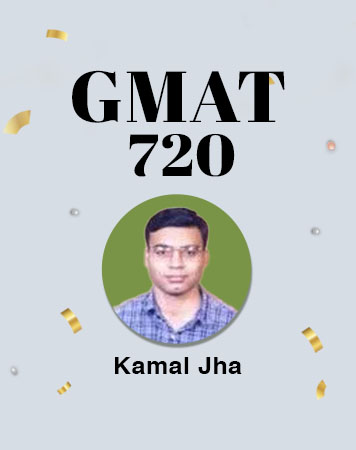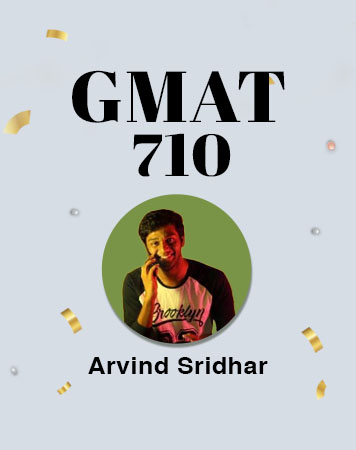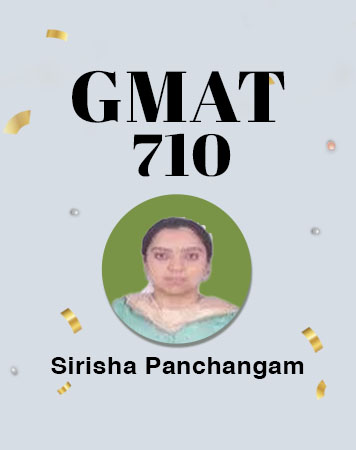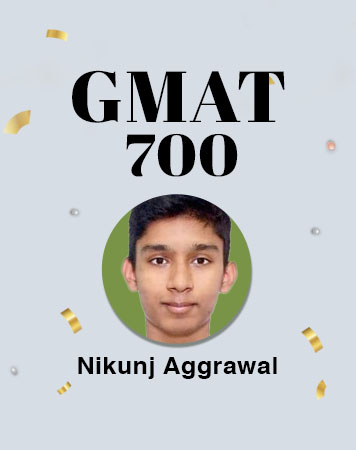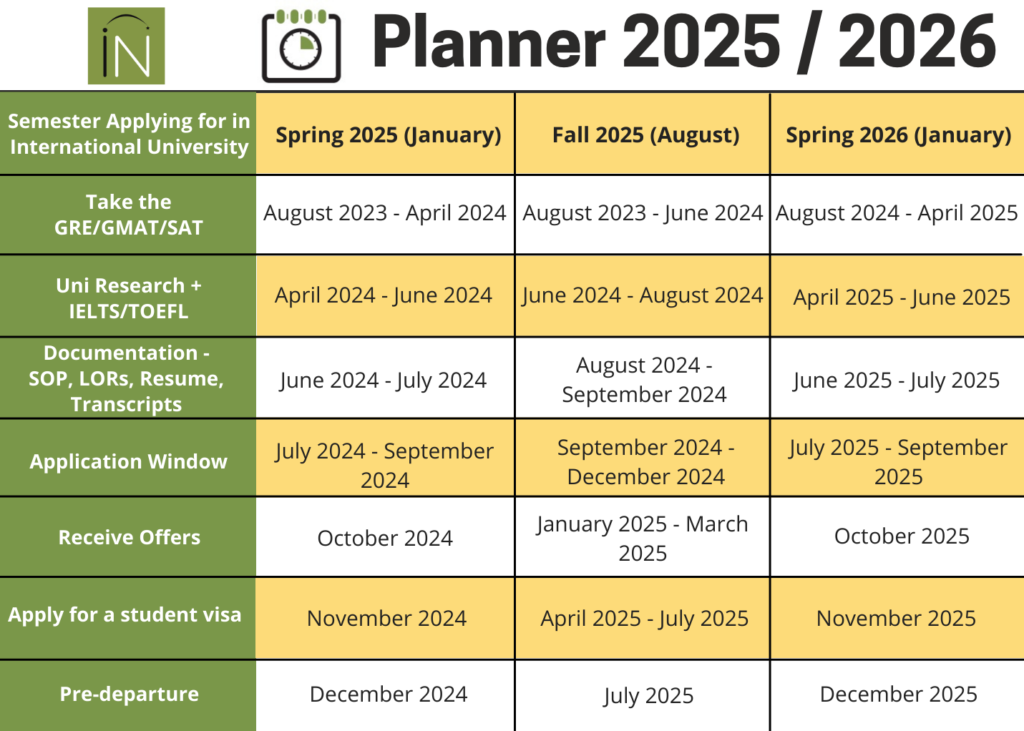Get in Touch
Call us on: +91 8928323711 / +91 9167255434
OR
Fill in the details to get personalized advice from our experts!
GMAT Coaching Program Features
- CLASSROOM TRAINING
- Group
- Instructor-led training
- Small batches (8-10 students)
- Individual attention
- Weekends and weekdays batches
- Study material
- Topic wise tests
- 15 online adaptive tests
- Instructor-led unlimited doubt solving
- Video sessions support
- Access to library
- Dedicated mentor support
- Free profile assessment session
- Enroll Now
- CLASSROOM TRAINING
- One-on-One
- Instructor-led training (face to face)
- Customized study
- Maximum individual attention
- Flexible timings
- Study material
- Topic wise tests
- 15 online adaptive tests
- Instructor-led unlimited doubt solving
- Video sessions support
- Access to library
- Dedicated mentor support
- Free profile assessment session
- Enroll Now
- LIVE ONLINE TRAINING
- One-on-One
- Instructor-led training (online)
- Customized study
- Maximum individual attention
- Flexible timings
- Study material
- Topic wise tests
- 15 online adaptive tests
- Instructor-led 10 hours doubt solving
- Dedicated mentor support
- Free profile assessment session
- Enroll Now
6 Reasons Why You Must Join Inspirus GMAT Coaching Classes

GMAT Top Scores

Individual Focus

Customised Program

Exhaustive Study Material

Practice Tests

Video Lectures
About GMAT™
WHAT IS THE GMAT TEST?
The GMAT (Graduate Management Admission Test) is a pre-requisite for admission to U.S. universities for business programs. The total exam time is 3 hours and 7 minutes, not including two optional 8-minute breaks standardized exam designed to predict how test takers will perform academically in MBA (Masters in Business Administration) programs. GMAT scores are used by 7000 programs across 2300 graduate business schools across the world in order to make admission decisions. For e.g. ISB (Indian School of Business) in Hyderabad requires the GMAT score for one to be considered for its MBA programs.
GENERAL OVERVIEW
The GMAT test is broken up into four sections. The Verbal and Quantitative Sections are jointly scored on a scale of 200 to 800 points. The Analytical Writing section is scored on a separate scale of 0 to 6, while the Integrated Reasoning section is on a scale of 1 to 8.
The GMAT can be attempted once every sixteen days and only up to five times in one calendar year.
You can register at: www.mba.com
THE CONTENT
Analytical Writing: The Analytical Writing Assessment (AWA) consists of one 30-minute writing task of analysis of an argument. The new GMAT replaced the analysis of an issue with the Integrated Reasoning section. This section requires test takers to critique an argument based on its reasoning.
Integrated Reasoning: The Integrated Reasoning section measures your ability to understand and evaluate multiple sources and types of information – graphic, numeric, and verbal, as they relate to one another; use quantitative and verbal reasoning to solve complex problems, and solve multiple problems in relation to one another. The integrated reasoning section tests students’ ability to analyze and synthesize a compilation of data, presented in different forms such as words, charts, and tables. There are 12 questions in the integrated reasoning section of the exam and the duration is of 30 minutes.
Quantitative: The Quantitative section of the GMAT has 31 questions that test takers are given 62 minutes to complete. Many of the math questions are high school level – there is no calculus or trigonometry – but test takers should be sure they have confidence in their knowledge of the basic concepts, rules, and equations for these mathematical subjects. It consists of two types of questions: data sufficiency and problem-solving, both of which test the application of various basic concepts of arithmetic, algebra, and geometry.
Verbal: The verbal section of the GMAT gives you 65 minutes to answer 36 multiple-choice questions. The questions are designed to test your ability to comprehend written material, evaluate arguments, as well as identify and correct grammatical errors. Your performance on the GMAT verbal section will receive a scaled score of 6–51. It consists of questions of three types: reading comprehension, critical reasoning and sentence correction. . The sections measure the test taker’s ability to read and comprehend the written material, reason and evaluate arguments, and correct written material to conform to standard written English.
List of B-Schools Accepting GMAT Scores in India
- IIM, Ahmedabad (PGPX)
- IIM, Bangalore (EPGP)
- IIM, Calcutta (PGPEx)
- IIM, Indore (EPGP)
- IIM, Kozhikode (EPGP)
- IIM, Lucknow (IPMX)
- Indian School of Business, Hyderabad/Mohali
- Institute of Management Technology (IMT), Ghaziabad
- Management Development Institute (MDI), Gurgaon
- XLRI, Jamshedpur
- Indian Institute of Foreign Trade (IIFT), Delhi
You can view the complete list at https://www.mba.com/
OTHER INFORMATION
To check where the GMAT™ is administered in your city, visit the official search page.
For further information visit: http://www.mba.com
GMAT™ is a registered trademark of the Graduate Management Admission Council.
The GMAT test has four parts– Quantitative Reasoning, Verbal Reasoning, Analytical Writing Assessment, and Integrated Reasoning.
FAQs
The GMAT stands for “Graduate Management Admission Test”.
The Graduate Management Admission Council (GMAC) owns and operates the test.
The GMAT is to target the current-generation skills that are most relevant to success in graduate management programs.
The GMAT test is administered online via two convenient options: Test at home, and Test at Center.
The Data Insights section, the Quantitative section, and the Verbal Reasoning section of the GMAT Focus Edition are computer-adaptive. It means as you answer each question, the computer scores your answer and uses it as well as your responses to any preceding question to select the next question. If you answer the first question correctly, the computer will usually give you a harder question. If you answer the first question incorrectly, your next question will be easier. This process continues until you complete the section
It takes up to 3-5 days business days to receive the GMAT score.
The GMAT scores are valid for 5 years.
To retake the test, you have to wait for 16 days between appointments for all GMAT exam attempts.
- The GMAT approved identification
- Appointment confirmation email
The GMAT is conducted round the year.
Once you pay the registration fee of $275, GMAC allows you to send your official GMAT scores to a maximum of 5 colleges for free. You can pay an additional fee of $35 each for sending your additional score reports to more than 5 selected colleges.
The earlier a student takes the GMAT, the better it is. First, determine when you plan to attend grad school. If it’s within the next 12-15 months, you’ll want to begin looking at GMAT test dates and register for an exam. Once you’ve determined when you’ll take the test, it’s best to start studying 4-6 months in advance.
The GMAT is a widely accepted business school entrance exam. At many of these universities and colleges, the GMAT is a significant element to the admissions procedure onto an MBA or MiM program. For example, if you’re applying to top-ranked business schools abroad, a GMAT score is a prerequisite. However, at many international business schools, a GMAT score isn’t mandatory for admission, though a high score can earn you extra points from the admissions team.

